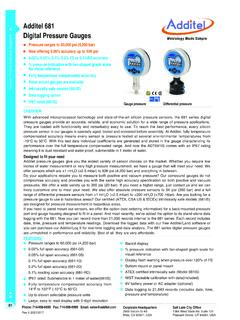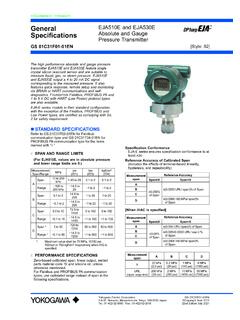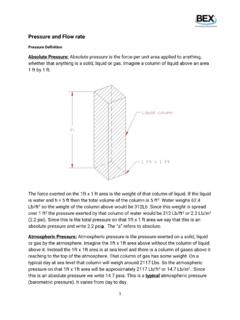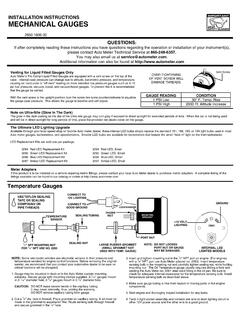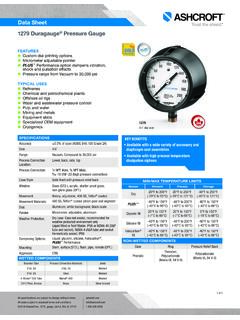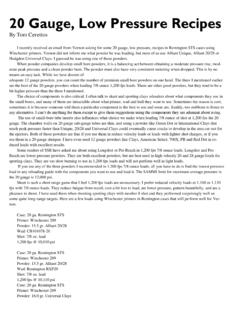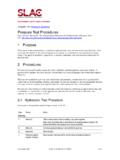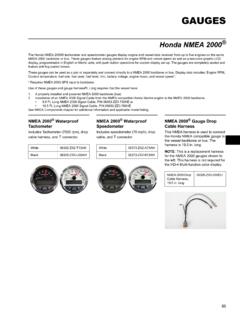Transcription of Understanding Vacuum and Vacuum Measurement
1 Understanding Vacuum and Vacuum MeasurementATMOSPHERESATMOSPHERESVACUUM FURNACEREFERENCE SERIES9 NUMBERU nderstanding Vacuum and Vacuum MeasurementSOLAR ATMOSPHERES, By: Re l J. Fradette, Senior Technical Consultant, Solar Manufacturing, : William R . Jones, CEO, The Solar Atmospheres Group of CompaniesTrevor Jones, Principal Engineer, Solar Atmospheres, Inc. Editor: Patricia Niederhaus, Executive Technical Administrator, Solar Atmospheres, & Illustrations: Andrew Nagy, Graphic Designer, Solar Atmospheres, Vacuum and Vacuum MeasurementThe purpose of this paper is to provide a better Understanding of Vacuum , including an explanation of Vacuum , a definition and description of Vacuum measuring instrumentation and an explanation of their application to Vacuum furnace VacuumVacuum can be defined as a space that is empty of matter.
2 However, achieving such an empty space is essentially impossible on earth. Instead, Vacuum is best described as a space with gaseous pressure much less than atmospheric pressure . Physicists and Vacuum scientists describe this lack of a perfect Vacuum in manmade chambers, such as production furnaces, as partial pressure or partial Vacuum . 1 The quality of a Vacuum is indicated by the amount of matter remaining in the system, so that a high quality Vacuum is one with very little matter left in it. Vacuum is primarily measured by its absolute room temperature and normal atmospheric pressure , one cubic foot ( cubic m) of air contains approximately 7 1023 molecules moving in random directions and at speeds of around 1,000 miles per hour.
3 2 The momentum exchange imparted to the walls is equal to a force of (psia) pounds for every square inch of wall area. 2 This atmospheric pressure can be expressed in a number of units, but until relatively recently it was commonly expressed in terms of weight of a column of mercury 760 mm high. 2 Thus, one standard atmosphere equals 760 mm Hg. Creating a Vacuum - The PumpdownThe pumpdown process begins with air at atmospheric pressure in a chamber attached to a Vacuum pump. The Vacuum pump removes gas molecules from the chamber to reach the desired Vacuum .
4 Air at atmospheric pressure is a combination of gasses as shown in Table 1. The relative gas composition will be important later on in this paper. Gas molecules are always moving and colliding, molecule to molecule. Gas molecules at atmospheric pressure are very close together, so the collisions are very distance between molecules is a function of pressure and is known as the mean free path (MFP). 3 As the chamber is pumped down into Vacuum and molecules are removed, the MFP becomes greater and pressure decreases in a chamber, fewer molecules are present and the mean free path increases.
5 Similarly, as the gas density reduces, there are fewer chances of molecular collision. This correlation between the MFP and pressure is shown in Figure 1. Air molecules are usually removed from the chamber through a type of positive displacement pump such as an oil-sealed rotary Units of MeasurementMeasuring Vacuum , as with any kind of measuring, requires standard units of measure. Inches or millimeters of mercury, torr, and micron are three units of measure typically associated with the Vacuum furnace industry. Other fields of Vacuum use Pascals (Pa or kPa.)
6 Air Composition at 50% Relative + + + + + + + + + +9 TorrFeetFigure 1 - Mean Free Path Vs Pressure2 Understanding Vacuum and Vacuum MeasurementBecause of the work of 17th century scientist Evangelista Torricelli, we know that the atmosphere generally exerts enough pressure at sea level to support about a 30-inch (760mm) column of mercury. From that foundation, we can measure decreases in atmospheric pressure in terms of inches or millimeters of mercury. Thus, a 10% drop in atmospheric pressure would indicate a 3-inch fall in the height of our column of mercury.
7 In this way, Vacuum came to be measured by the difference between normal atmospheric pressure and pressure in the system being measured. Thus, a 10% decrease in gas density from atmospheric pressure would be measured as a 3-inch Vacuum . For everyday Vacuum measurements such as in weather forecasting, inches of mercury function well, but for measurements on a finer scale, other units are needed. One torr, a unit named in honor of Torricelli, is equivalent to one millimeter of mercury, yielding the figure of 760 torr as normal atmospheric pressure at sea level.
8 Torr as units of measure are typically used for vacuums in the 1 to 760 Torr range. For measurements of Vacuum on an even smaller scale, the micron is the term of use. One micron is equal to 0 .001 Torr (10-3 Torr). Microns (represented by the symbol ) are typically used to measure vacuums in the range of 10-3 to 1 Torr. For heat treating purposes, torr and micron are the most commonly used units of measure. Table 2 gives conversion factors for the three units discussed LevelsVacuum quality is subdivided into ranges according to the technology required to achieve it or measure it.
9 A typical distribution of the universally accepted ranges can be found in Table 3. 1 Atmospheric pressure is variable but is standardized at 760 Torr or Vacuum also called rough Vacuum , is a Vacuum that can be achieved or measured by basic equipment such as a Vacuum Vacuum is a Vacuum that is typically achieved by a single pump, but the pressure is too low to measure with a mechanical manometer. It can be measured with a McLeod gauge , thermal gauge , or a capacitance gauge . (Instrumentation to be discussed later.)High Vacuum is Vacuum where the MFP of residual gasses is longer than the size of the chamber or of the object under test.
10 High Vacuum usually requires multi-stage pumping and ion gauge Measurement . NASA has revealed that the Vacuum level recorded on the moon was 1x10-9 Torr. 1 Ultra-High Vacuum requires baking the chamber to remove trace gasses and other special procedures. Most standards define ultra-high Vacuum as pressures below 10-8 To r r .Deep Space is generally much emptier than any artificial Vacuum is an ideal state of no particles at all. It cannot be achieved in a laboratory, although there may be small volumes which, for a brief period, happen to have no particles of matter in them.

